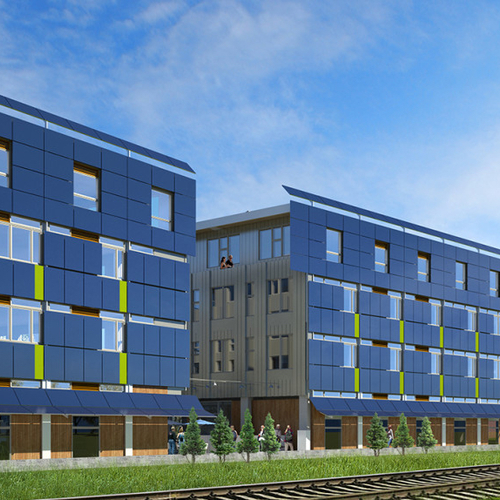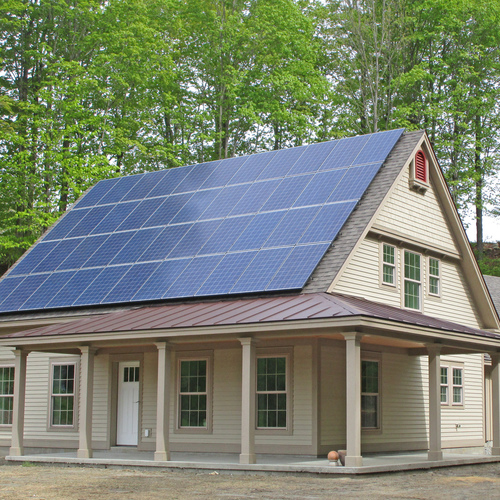
Image Credit: Carmen Shields via Flickr
UPDATED on Nov. 10, 2015
Officials in Boulder County, Colorado, are bringing more new houses into the net-zero energy fold.
Beginning on January 1, houses of 5,000 square feet or more will be included in the county’s BuildSmart program. Originally put in place in 2008, the program is part of a broad initiative designed to reduce greenhouse gas emissions, and already requires new dwellings of 6,000 square feet and larger to meet the net-zero requirement.
The rule applies only to houses in unincorporated parts of the county, not to incorporated municipalities such as Boulder and Longmont.
Ron Flax, the building sustainability examiner for the county, told GBA that in 2013, 2014, and the first half of 2015, there were 94 new homes built in the unincorporated part of the country, 36 of which were 5,000 square feet or larger and about a dozen of them with a HERS rating of zero or lower. The goal of land-use planning has been to push more residential construction to incorporated towns and cities, most of which have their own building departments. “It’s tough to guess what the future holds,” he said.
Flax said by email that when the BuildSmart program began, all homes of 8,000 square feet or more were required to have a HERS score of zero (or below). Later, the threshold was lowered to 6,000 square feet.
In this latest revision, commissioners had considered extending the requirement to houses of 4,000 square feet or more, but in the end settled on the 5,000-square-foot threshold.
The county’s ultimate goal is to have all new homes be capable of producing as much energy as they consume on an annual basis by 2022. The requirement would not apply to existing houses or those being remodeled.
Higher construction costs predicted
The average new home in Boulder County is about 4,000 square feet, with construction costs of roughly $200 per square foot. Without offering a breakdown, the Daily Camera said that adding renewables with enough capacity to power an average house would add about 15% to construction costs, or $120,000.
The 15% estimate comes from local architects and builders and is the “generally accepted cost associated with net-zero builds,” the article said.
Not so, Flax said.
Net-zero energy homes can be built for market or near market prices and don’t require a premium approaching 15%, he said. But conventional designs with lots of glazing might indeed require very large renewable systems to meet the net-zero requirement.
“We have put considerable efforts into understanding the cost implications of our regulations,” he said in an email. “What we have found is that when building large custom homes there is no simple relationship between construction costs and energy efficiency. It is important to know that we have almost no production home activity in Boulder County.
“When people are building custom homes, if they are properly incorporating energy efficiency in their initial designs then the added cost for a HERS of zero is manageable,” he continued. “If the design team is ignoring energy efficiency and then trying to figure out how to hit a HERS zero after the major decision are already made, the costs can indeed become significant.”
Flax added that the county is addressing energy conservation in other ways, including required offsets for big energy users like heated swimming pools, snow-melt systems, and hot tubs, and efforts to help the many cannabis growers in the area to adopt more efficient production methods.
County Commissioner Elise Jones told the Longmont Times-Call it makes sense to apply the net-zero energy rule to larger homes because they’re bigger-than-average energy consumers. Commissioners believe that holding off on applying the standard to houses of 4,000 square feet or more represented a “balanced approach to creating homes that have minimal impact on the environment,” the report said.
The Daily Camera said that Boulder County “may be the only government in the U.S.” to legally require all new homes meet the net-zero energy standard by 2022.
“Nationally, there are communities and states with net zero goals,” Jim Meyers of the Southwest Energy Efficiency Project told the paper. “But the plans do not specify to the level of detail that Boulder County has specified.”
This post was updated to correct the year in which the BuildSmart program began, and to add comments by Ron Flax about the added costs of building net-zero houses
Weekly Newsletter
Get building science and energy efficiency advice, plus special offers, in your inbox.















3 Comments
How many have been built?
The article doesn't say if any net zero homes have actually been built to meet the prior requirements for homes larger than 6000 square feet to be net zero. Maybe they are just shutting down development in the unincorporated areas. " The goal of land-use planning has been to push more residential construction to incorporated towns and cities, most of which have their own building departments."
Any guesses as to the size of PV array
Any guesses for the energy requirements per year of an 8000 sq ft house in Boulder County. At Passivhaus standard they would need 12,000 kwh year for heat. If we estimate at Passivhaus allowance for total energy at 110 kwh per sq meter then 90,000kwh year. But that includes that "grid multiplier" of 3.1 so lets divide by that and get 28,000 kwh year. That is maximum allowable, so perhaps with ground source heat pumps and high efficiency appliances and lighting etc we can get to 25,000kwh/year. So that requires a PV array of about 15 kw to net zero the house. That should be possible on rooftop with PV panels at 22% efficiency. What do you think? Am I close?
I like this approach, if you
I like this approach, if you can afford very expensive you can afford to eliminate your electrical carbon. And over time as costs keep falling everyone will have to reduce their electrical carbon.
This would also mean that new power plants don't have to be upsized to anticipated higher future requirements.
Log in or create an account to post a comment.
Sign up Log in